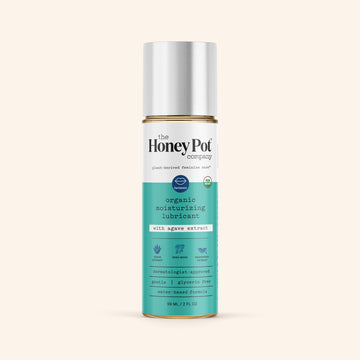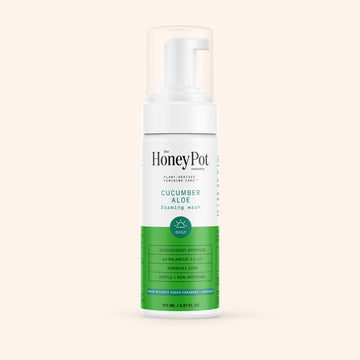Sometimes referred to as “The Superhero in the Vagina,” Lactic Acid is produced by the bacteria lactobacillus, which is naturally occurring in a healthy vaginal ecosystem.
Let’s get into the science.
What Is Lactic Acid?
Lactic acid isn't just a term tossed around in science labs or skincare routines — it's a major player in the vaginal ecosystem, especially when it comes to those of us navigating life with a vagina. So, what exactly is this buzz-worthy substance?
Produced by lactobacillus bacteria — the friendly microbes calling your vaginal environment home — lactic acid is a natural byproduct of their existence. These bacteria munch on glycogen, leaving behind lactic acid, which plays an important role in the microbiology of the vaginal flora.
Why Is Lactic Acid Important?
You might be nodding along, thinking, "Cool, cool, lactic acid sounds nifty," but its job description covers some pretty crucial ground in maintaining not just vaginal health but your overall well-being.
Here’s the scoop:
-
Keeps the pH in Check: Lactic acid ensures your vagina maintains its optimal pH level of 3.5-4.5. This mildly acidic environment is like a protective bubble against unwanted guests, keeping infections at bay.
-
Natural Defender: By maintaining this acidic pH, lactic acid is essentially putting up a "No Vacancy" sign for pathogens. It's your personal bodyguard against the likes of yeast infections (candida) and bacterial vaginosis.
-
Promotes Good Bacteria: Just like a garden thrives with the right kind of care, so does your vaginal microbiome. Lactic acid helps the good bacteria flourish, making it tough for the not-so-friendly bacteria to take over.
-
Supports Moisture Balance: Beyond its protective role, lactic acid plays a part in keeping things comfortably moisturized down there. It's like the unsung hero of hydration for your intimate areas.
In a nutshell, lactic acid is doing a lot of heavy lifting behind the scenes. It's about as close as you can get to a superhero in your vaginal ecosystem, ensuring that everything runs smoothly, stays balanced, and remains healthy. And in the world of vaginas and their companions, that's pretty much the gold standard.
What Is the Role of Lactic Acid in Preventing Infections
Now, let's zoom in on how antimicrobial lactic acid rolls up its sleeves to guard against the uninvited — those pesky infections that can turn your day from good to "Please, can I just stay in bed?"
Frontline Defense Against Bacterial Vaginosis
Nobody wants to deal with bacterial vaginosis (BV). It's like that annoying guest who overstays their welcome.
The effects of lactic acid help maintain the acidic pH that keeps BV at a distance. By fostering an environment where vaginal lactobacillus-dominated bacteria thrive in your vaginal discharge, lactic acid ensures that the risk of BV is minimized.
It's all about balance, and vaginal lactic acid is the master of maintaining it. If kept in balance, you can avoid annoying vaginal gels like Metronidazole. And definitely don’t believe anything you read online about hydrogen peroxide rinses.
A Shield Against Pathogens
Pathogens are those troublemakers that can lead to infections and discomfort. Lactic acid creates an unwelcoming environment for these pathogens, effectively reducing the likelihood of vaginal infections. Think of it as having a shield that guards against invaders, ensuring they don't settle in and cause problems.
Keeping Tract Infections in Check
The urinary tract is another area where infections can be a real pain. While lactic acid primarily focuses on vaginal health, its role in promoting a healthy vaginal microbiota indirectly supports the urinary tract. By preventing the overgrowth of harmful bacteria in the vagina, lactic acid helps reduce the risk of these bacteria migrating to the urinary tract, thereby protecting against tract infections.
Combatting Sexually Transmitted Infections (STIs)
While lactic acid isn't a cure-all for STIs, its role in maintaining a healthy vaginal environment can be a contributing factor in reducing the prevalence of sexually transmitted infections like chlamydia or gonorrhea. By supporting the vaginal microbiome's integrity, lactic acid may help the body's natural defenses be more effective against potential STI pathogens.
Tips for Maintaining Vaginal Health
Keeping your vaginal health in top shape is simpler than you might think. Here’s how to support your body’s natural balance with ease:
Embrace Probiotics
Integrating probiotic-rich foods or supplements into your diet can bolster your vaginal microbiome. Probiotics — especially those containing strains of Lactobacillus species — contribute to a thriving community of beneficial bacteria, reinforcing the protective barrier against unwanted microbes like Gardnerella.
Mind Your Menstrual Products
Choosing menstrual products should be about comfort, yes, but also about keeping your vagina's environment in mind. Our organic cotton pads are here to do just that. They're like a soft hug for your vagina, minus any unwanted drama to your pH levels.
Stay Hydrated
If there’s one thing that’s universally good for you, it’s water. It keeps everything running smoothly, from flushing out toxins to keeping your vaginal area lubricated with vaginal fluid and less prone to irritation.
Consider Your Contraceptive
Not all contraceptives gel well with every vagina. Some might mess with your hormonal vibe or even throw off your vaginal flora’s groove. Having a heart-to-heart with your healthcare provider can help you land on the method that fits your body's unique script.
Practice Safe Sex
Using barriers like condoms during sexual intercourse can protect against sexually transmitted diseases (STDs) and infections (STIs), which can disrupt your vaginal microbiome and pH levels. It’s a pretty simple step that can have a pretty big impact on maintaining vaginal health.
So what about the Lactic Acid found in The Honey Pot’s washes?
When formulating our washes, pH has always been top of mind and based upon ever-evolving research, we found Lactic Acid to be the most effective and targeted solution.
Lactic Acid has gentle moisturizing properties that also support a balanced pH range of 3.5-4.5. The addition of Lactic Acid to our Honey Pot washes ensures the effectiveness of the formula you know and love, with an added twist of rich cleansing and soothing hydration.
The Bottom Line
In the grand scheme of things, lactic acid isn't just a detail in the complex world of vaginal health; it's a cornerstone. It's the secret sauce in our washes, the hero that maintains the delicate balance of your vaginal pH, ensuring everything down there is functioning just as it should.
From combatting pesky microorganisms to regulating your menstrual cycle, lactic acid has got your back, minimizing side effects and promoting a healthier genital area.
Remember, caring for your vagina is a vital part of your overall well-being, and understanding the role of lactic acid is a big step in the right direction. With Honey Pot, embracing the power of naturally derived, plant-powered care is simple.
Here's to feeling balanced, comfortable, and empowered every day.
Sources:
Lactic acid test | MedlinePlus Medical Encyclopedia.gov





